This page looks at the utilisation of alternative fuels especially those derived from renewable resources and waste materials.
Of particular interest are :
New methods for charcoal burning to improve cycle time and yield
Sustainable woodland management
Wood Gasification as a Western World heating fuel and a developing world fuel for cooking stoves.
Wastewatts - the conversion of waste into electricity and domestic heating.
Warning: Woodgas contains high percentages of the toxic gas carbon monoxide which can be lethal if breathed in even low concentrations.
Never experiment with wood gas stoves indoors or without adequate ventillation.
The gasification of wood and other biomass materials, is a technology known for 150 years. It was used extensively in the 1940s, when as many as 1 million wood gas powered vehicles were in use in Scandanavia.
Modern gasifier designs are more efficient and are being used extensively in developing countries.
Fluidyne NZ have been researching and devoloping practical gasifier technology for more than 25 years. Their website contains a wealth of information.
Dr. Tom Reed, runs a Gasification news list, and this provides a web- based forum for discussion of gasification topics. He also runs a list discussion group on Cooking Stoves - particularly for developing countries.
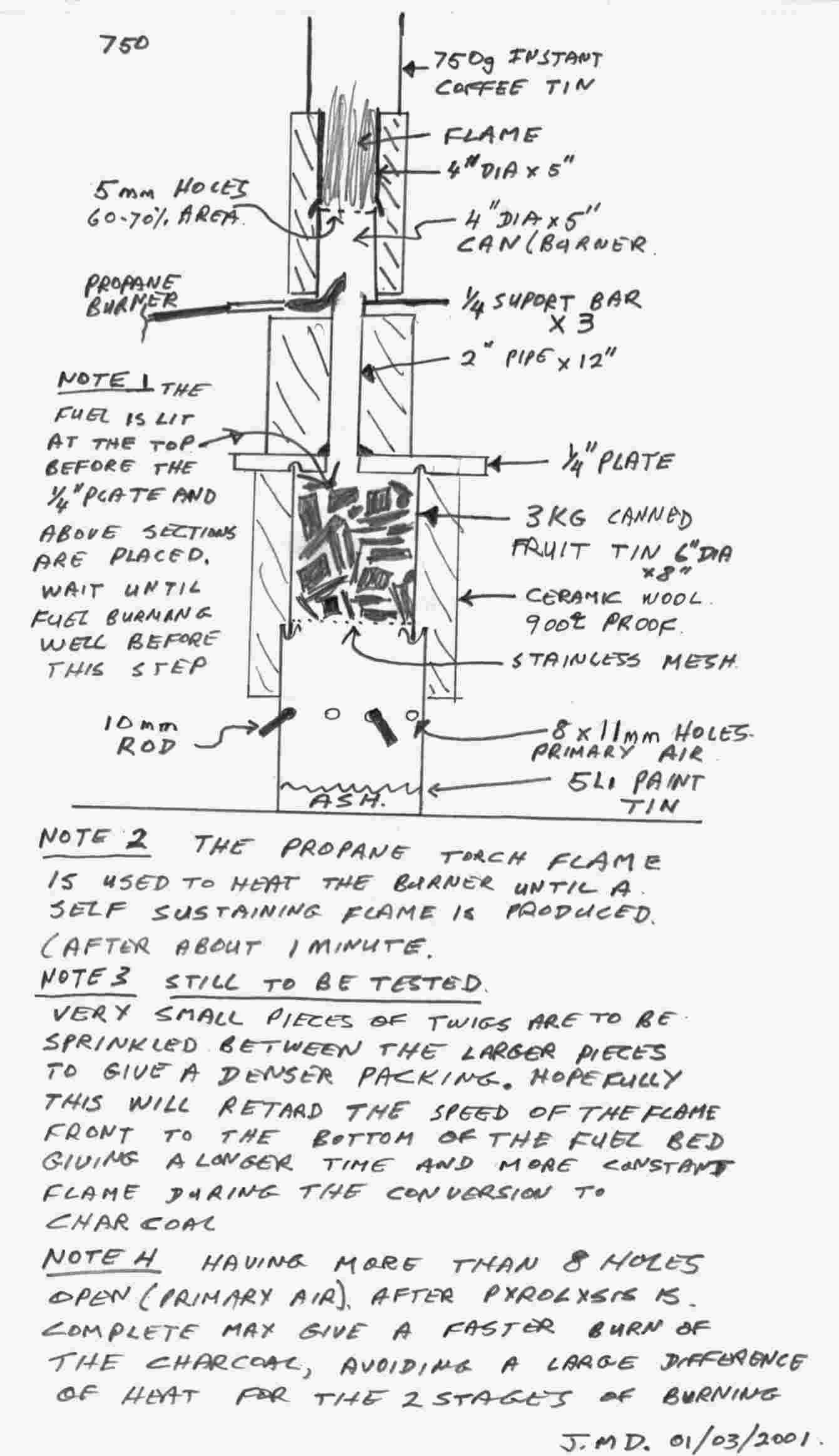
Since Neolithic times, the practice of coppicing has been employed in English woodlands.
The Romans coppiced large areas of the Weldon countryside as a means of fuelling their iron works. By the Middle Ages, short rotation coppicing (every 6 years) was the main form of woodland management.
In Tudor times, the practice was used to preserve the larger timber required for shipbuilding for the King's Navy, and it became an offence to fell large trees for firewood and charcoal burning.
As a result, hazel and willow were planted, which produce many side-shoots from where the main trunk has been removed. These varieties are fast growing and were harvested on a 3 year or 7 year cycle. Willow and hazel shoots were an important material for basket weaving and fencemaking.
The result was a sustainable supply of well managed timber ideally suited to charcoal production.
With a little incentive, this practice could easily be reinstated in many of England's derelict broad leaved deciduous woodlands.
For more detailed information on coppicing, pollarding and woodland management, click here.

Key to this process is the clean conversion of waste material into thermal energy by means of pyrolisis or gasification and the subsequent conversion of the heat energy into electrical power using a prime mover based on external combustion technology.
Most of the information is on the
second Wastewatts site which looks at alternative fuel technologies and appropriate heat engines to provide a source of heat, mechanical power and electricity from either waste products or sustainable fuels. The conversion of waste material into useful energy whether it be a source of heat or electric power requires several key technologies to enable this to be done effectively, efficiently and with minimal pollution.
The technologies which are currently of interest are the management of sustainable woodlands to provide a renewable source of fuel and then the gasification of the wood (or biomass, agricultural waste etc) to wood gas which can then be burnt cleanly in an external combustion engine.
The other useful source of heat energy is waste oil, either waste vegetable oil from food manufacturers, restaraunts or the kitchen, and automotive sump oil. Both these types of oil have a high calorific value and with suitable burner technology, such as the Babington Burner, allow them to burnt cleanly and efficiently.
The heat energy is then used to power an external combustion engine such as a Stirling engine, Manson engine, or steam engine.
www.geocities.com/wastewatts
The Wastewatts Forum hosted by Yahoo Groups discusses some of the technology used for converting waste or alternative fuels into useable energy either in the form of heat or electric power. Its primary aim is to draw attention to alternatives to petrochemical fuels and reduce the reliance of the internal combustion engine. Other pages on this site deal with Stirling Engines, steam engines and Electric Vehicles. For more Wastewatts links such as Wood gasification, biofuels and sustainable energy resources visit the Wastewatts list.
1.5MB Downloadable Zipfile
Steam Cars
One day I will drive a hybrid steam car. Until then, read about some other steam car enthusuasts..
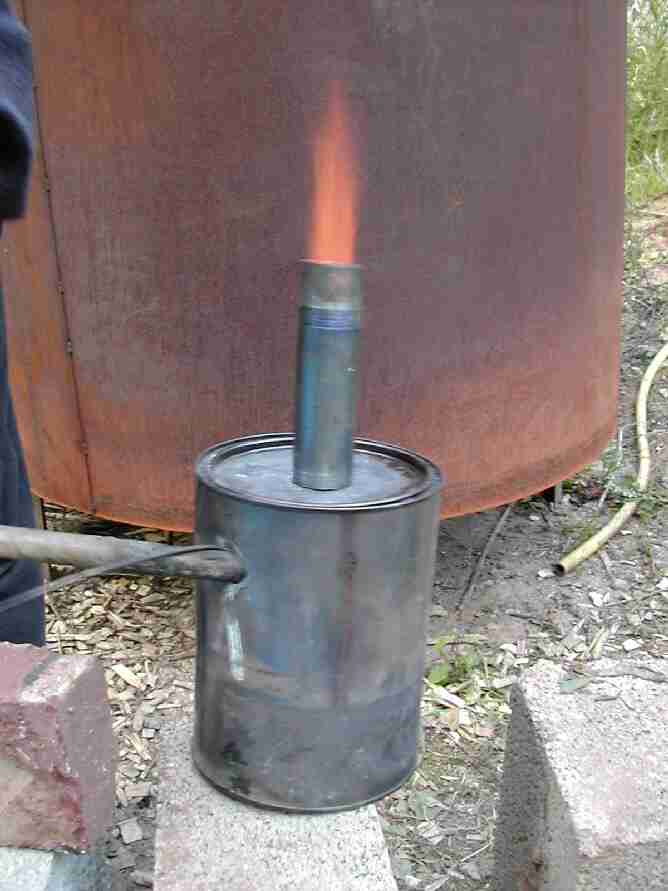
The picture above is a woodgas "Bunsen" burner made from a 2lb coffee tin. The burner is just a 6" piece of 1.5" steel pipe and the pipe to the left is connected to a dc blower fan - about the size of a computer fan. The thin wire seen entering from the left is the thermocouple probe.
Into the bottom of the can you put air dried woodchips, small twigs or other woody material. These are lit from the top and the forced air is turned on. The air pipe is angled downwards slightly to cause the air to swirl around the inside wall of the tin. An improved design would use a larger outer tin to enclose the coffe tin leaving about a 1" gap around the outside. The air from the blower passes around this gap and becomes pre-heated ( the coffee can currently gets red hot).
Just behind my demonstration burner is a much bigger version 1m in diameter and 1m deep! It can hold 100kgs of woodchips and burns for about 4 hours with a 100kW flame! It has been used for drying timber and for firing a charcoal retort.
The first step in many engineering processes is to achieve a reliable source of heat , for example the Blacksmith's forge provides the heat required to soften the iron to make it more malleable.
Woodstoves tend to be somewhat difficult to control, either they blaze or smoulder with not nuch in between. Wood can be a very variable fuel, and damp logs will soon upset an otherwise happy fire. One solution is to convert the raw wood fuel into wood-gas, by using heat to break up the compounds in the wood in a process called pyrolisis . The result is a mixture of flammable gases including carbon monoxide, hydrogen and methane. This gaseous mixture can then be burned in a burner - a bit like a blowlamp or Bunsen burner.
The wood is first prepared into small blocks or chips, an excellent fuel is the woodchips available from tee pruning or forestry work, small pieces offer more surface area and are more easily pyrolised.
There are several designs for gasifiers and they may be updraught, downdraught or a variation on these. Details may be found at this site.
My gasifier is of the downdraught type which was used extensively in Sweden during WW2 for providing a gaseous fuel to run Sweden's road vehicles.
One such gasifier was devised by an engineer called Kalle. Here is a 1942 article describing the Kalle Gasifier construction, translated from Swedish.
Fluidyne NZ has been producing gasifiers for 25 years and they have a good site describing the construction of a gasifier suitable for home construction,
Most impressive is their micro-gasifier pictured here producing a substantial hot flame.
They also present a full working design for running an engine of up to 2000cc, producing 10kWe - Pioneer Class Gasifier
Here is a good link site for gasifiers including a Yugo car converted to run on woodgas.
1. Gasifier made from old oil fired boiler
2. "Water Jacket" used as air pre-heater for both primary and secondary combustion air.
3. Electric blower fan, from fan assisted boiler provides positive pressure.
4. Charge capacity 75 litres or 2.65 cubic feet. Approx 37kg / 80lbs of wood.
5. Smelting furnace could be replaced by external combustion engine eg. Stirling, Manson or monotube boiler for steam engine.
See the burner in action on the Charcoal Burning Page!
Read more about Charcoal Burning practices here.
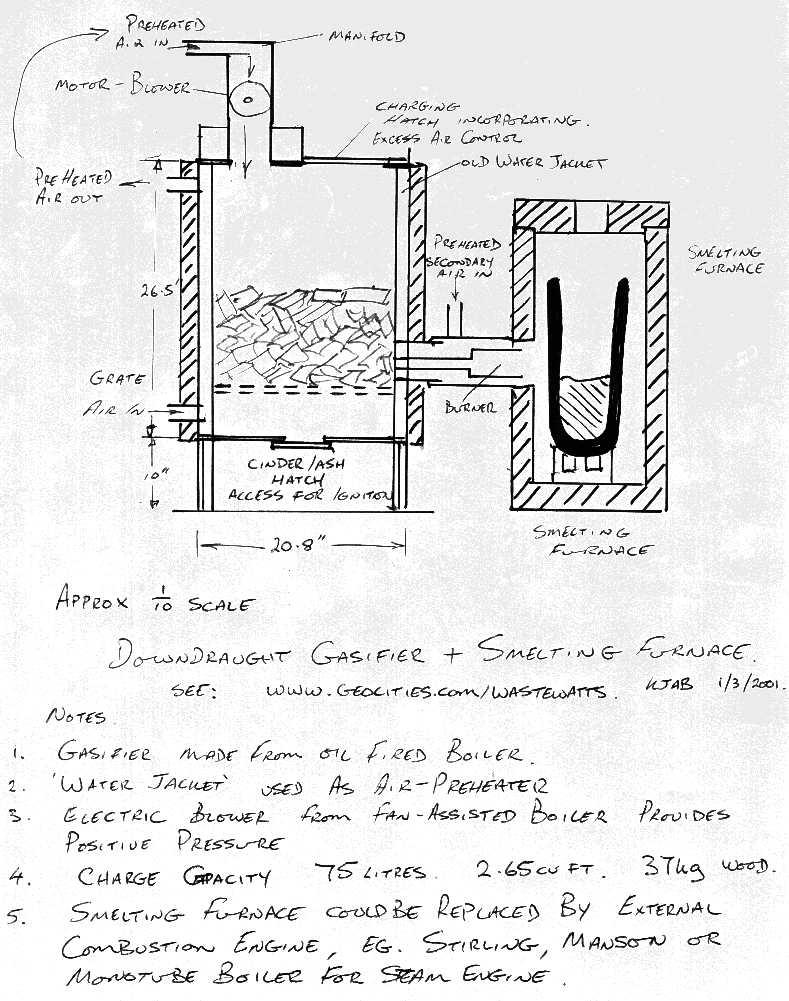
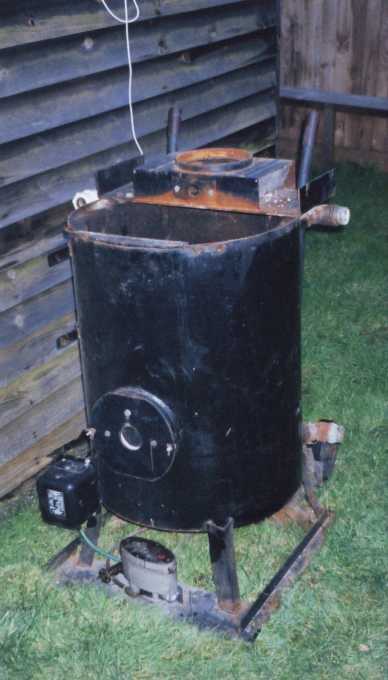
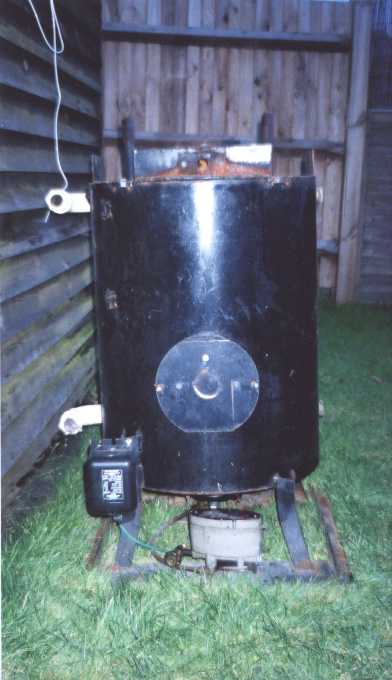
The existing container will be insulated with 50mm / 2" of rockwool or papercrete or similar insulation, held in place by a 0.6mm steel jacket. This can easily be made from a single 6' x 3' steel sheet or even an old oil drum.
If the fuel is damp, the steam generated will be drawn through the hot charcoal further reducing it to combustible gases.
A conical ash collector below the grate encourages the ash to collect in the centre, where it can easily be removed, for spreading on the garden.
